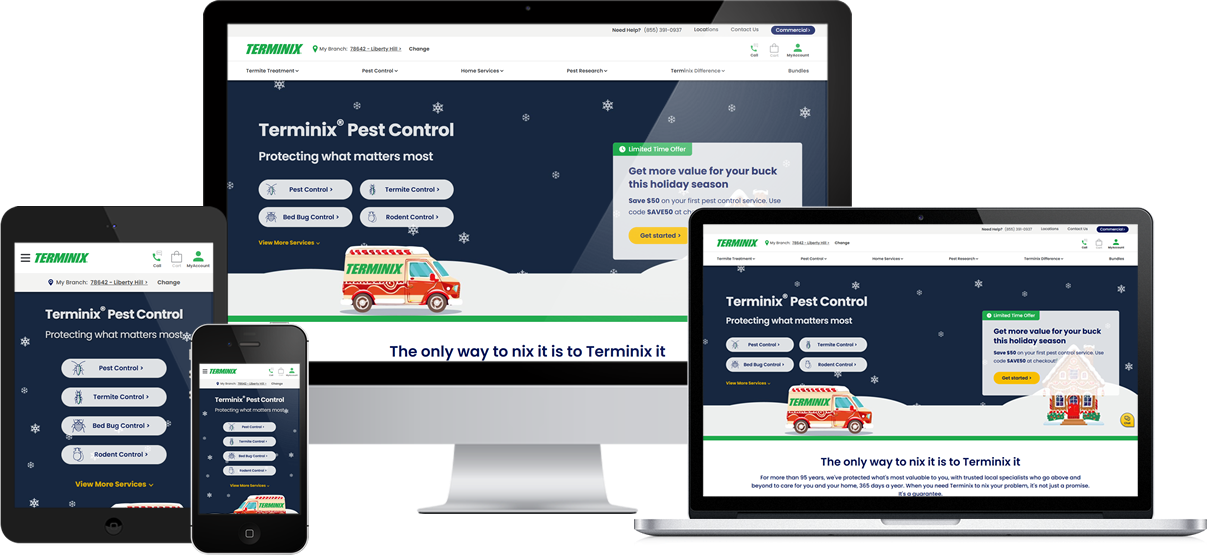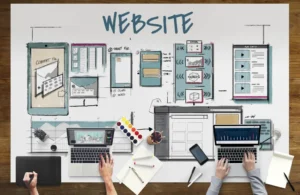
A Website Design That has Visual Appeal
It’s essential for your pest control website to stand out and avoid being overshadowed by competitors. A standout website isn’t just visually appealing—it’s well-structured and user-friendly, designed to drive potential customers to reach out to your business for their pest control needs.
Start by analyzing competitor websites to see what’s working well in the industry. Use these insights to ensure your site includes all the essential features your audience expects—then take it a step further by designing a website that’s more engaging, better organized, and has a better offering.
Boost Credibility and Trust with Customer Reviews
Nothing builds trust like reviews from satisfied customers. Many potential customers may never even reach your website and call you just from your Google Business Profile.
Your Google Business Profile reviews are a goldmine for building trust and attracting new customers. To maximize their impact, integrate these reviews into your pest control website and display them prominently. Position them where visitors will immediately notice, such as on your homepage or in the main navigation menu.
Avoid hiding them at the bottom of the page—make sure they are front and center to leave a lasting impression.
If you don’t have a Google Business Profile, you should get one asap. It’s free, easy to set up, and one of the most effective platforms for generating pest control leads.
Beyond customer reviews, showcasing your professional expertise and accomplishments can further establish your credibility. Highlight key achievements such as your years of experience, the number of successful projects completed, or any industry awards and certifications. These elements demonstrate your reliability and professionalism, giving potential clients even more confidence in choosing your pest control services.
Streamlined Navigation and Clear Calls to Action
When people visit your pest control website, they’re looking for quick and easy access to the information they need. They don’t want to waste time clicking through pages or scrolling aimlessly. That’s why a well-organized, user-friendly design is essential.
Ensure your website features clear navigation, concise pages that provide valuable information, and strategically placed calls to action that guide visitors to take the next step—whether that’s scheduling an inspection, requesting a quote, or contacting your team.
Ensure your mobile experience is as seamless as your desktop version. With many customers browsing on their phones, it’s vital to include click-to-call phone numbers and simple, mobile-friendly lead forms that make contacting your business on the phone easy.
Design a Website for Local SEO Success
When designing a pest control website, it’s crucial to incorporate onsite SEO strategies to ensure it performs well in local search results.
Keep in mind that onsite SEO alone won’t be enough to rank your pest control website for highly competitive keywords. However, it’s an essential part of building a website you shouldn’t overlook. Proper onsite search engine optimization sets the stage for long-term SEO success and ensures your website is ready for offsite strategies when you partner with an SEO agency.
Key onsite SEO items to include in your website design:
- Fast Page Loading: Ensure your site loads in less than 3 seconds to keep visitors engaged and improve search rankings.
- Clear URL Structure: Organize your URLs to reflect the content hierarchy, making it easier for search engines and users to navigate your site.
- Targeted Keyword Research: Identify the right keywords that potential customers use to search for pest control services.
- Proper Meta Tags: Every page should have unique, well-written meta titles and descriptions to enhance visibility in search results.
- Proper Heading Tags: Use a clear structure with one H1 tag per page and appropriately organized H2 and H3 tags for better readability and SEO.
- XML Sitemap: Include an XML sitemap to help search engines index your site efficiently.
The Pest Control Website Design Process

Planning & Visual Sitemap
Start with a comprehensive planning phase to outline your website’s structure, features, and goals. A visual sitemap helps map out the pages and navigation, ensuring the user experience is intuitive and aligned with your pest control business objectives.
Kick-Off and Asset Collection
Once the planning is complete, you will kick off the project by sharing essential assets such as your logo, branding guidelines, images, and any existing content. Your website designer should provide a file sharing resource for you to upload your assets.
Design
During the design phase, your website designer will transform your ideas into a visual layout, starting with the homepage. You’ll have the opportunity to review the design, share feedback, and request adjustments. Once all revisions are completed and the design meets your approval, the designer will proceed to design the remaining pages of your website.
It’s important to note that some designers charge extra for multiple rounds of revisions, which can add unexpected costs. Choosing a company like Contractor Gorilla, which provides unlimited design revisions at no extra cost, ensures you can adjust your design until you’re completely satisfied without worrying about additional fees.
Build
After the design is approved, the development phase begins. Your website is built using the latest technologies, ensuring it is fast, mobile-friendly, and optimized for search engines. Functional elements like contact forms, booking tools, and other third party scripts are also integrated.
Content Finalization
Content is finalized and uploaded during this phase. This includes written descriptions of your pest control services, customer testimonials, blog posts, and any assets. All content is reviewed for accuracy, SEO optimization, and readability.
Go Live—Hosting & Management
Once you give the thumbs up, it’s time to launch your home builders website live. If you’re hosting it yourself, you’ll provide your designer with access to your hosting, but if your designer is hosting the website, you’ll give them access to your domain name account.
Once your website is live, you’ll want access to your content management system to manage and maintain it. In some cases, your website designer may offer maintenance services and do updates for you.
Best Pest Control Website Designs in 2025
- Safe Guard Pest Control Services
- Trap pest control
- Rentokil Boecker
- Five Moons
- Truly Nolen
- Terminix
- Cook's Pest Control
- HomeTeam Pest Defense
- Orkin
- Fox Pest Control
- Alta Pest Control
- Clark Pest Control
- Arrow Pest Control
- Pestie
- Aerex Pest Control
- Green Home Pest Control
- Mission Pest Control
- Aruza
- Urbanex Pest Control
- All "U" Need Pest Control
Published by: admin in Web